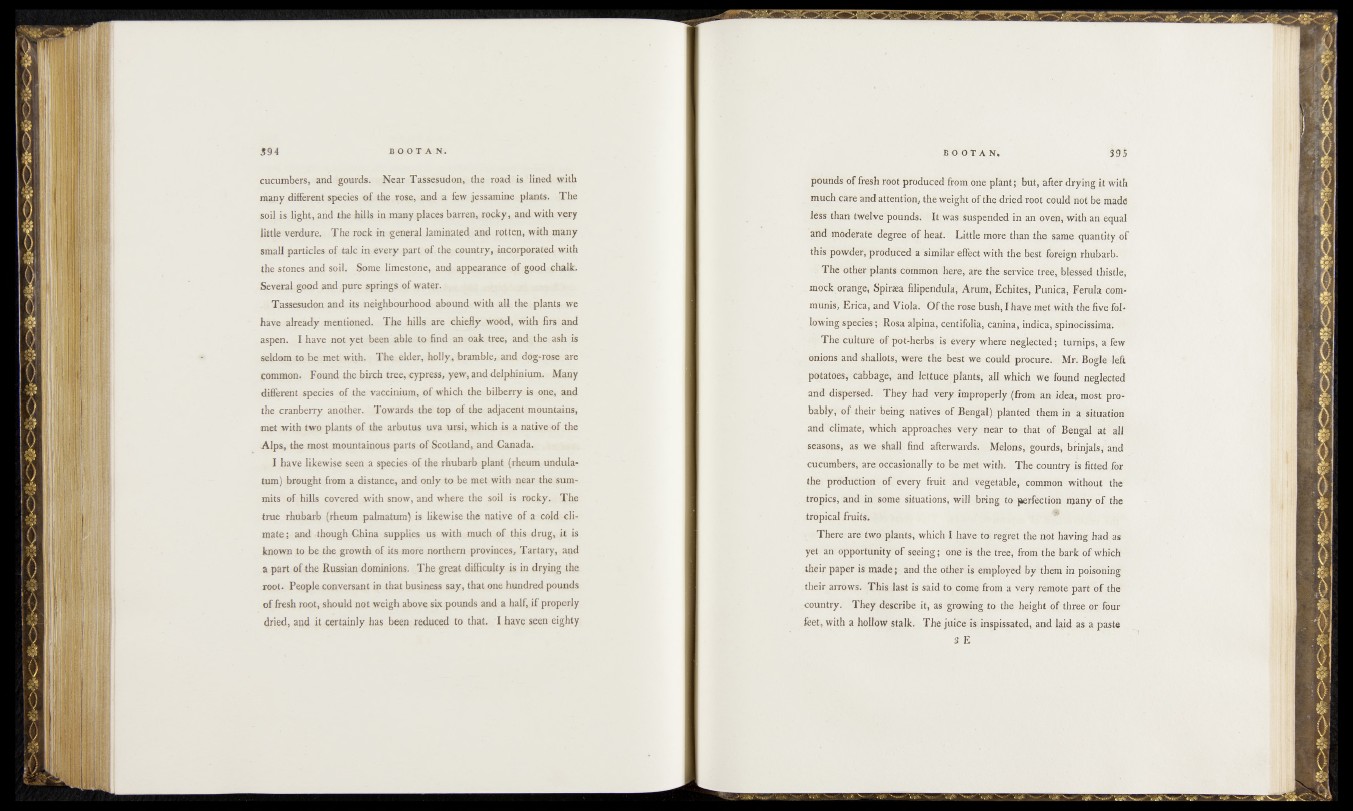
cucumbers, and gourds. Near Tassesudon, the read is lined with
many different species o f the rose, and a few jessamine plants. The
soil is light, and the hills in many places barren, rocky, and with very
little verdure. The rock in general laminated and rotten, with many
small particles of talc in every part of . the country, incmporated with
the stones and soil. Some limestone, and appearance of good chalk.
Several good and pure springs of water.
Tassesudon and its neighbourhood abound with all the plants we
have already mentioned. The hills are chiefly wood, with firs and
aspen. I have nut yet been able to find an oak tree, and the ash is
seldom to be met with. The elder, holly, bramble, and dog-rose are
common. Found the birch tree, cypress, yew, ami delphinium. Many
different species of the vacciniam, of which the bilberry is one, and
the cranberry another. Towards the top of the adjacent mountains,
met with two plants of the arbutus uva ursi, which is a native o f the
Alps, the most mountainous parts of Scotland, and Canada.
I have likewise seen a species of the rhubarb plant (rheum undula-
tum) brought from a distance, and only to be met with near the summits
of hills covered with snow, and where the soil is rocky. The
true rhubarb (rheum palmatum) is likewise the native of a cold climate;
and though China supplies us with much of this drug, it is
known to be the growth of its, more northern provinces, Tart ary, and
a part of the Russian dominions. The great difficulty is in drying the
root. People conversant in that business say, that one hundred pounds
of fresh root, should not weigh above, six pounds mid a half, if properly
dried, and it certainly has been reduced to that. I have seen eighty
pounds of fresh root produced from^ohe plant p but, after dryingit with
much care a «detention, thfe .wSight.ohtlJ^dried root could not' be made
less than twelve'pounds.1 It, was-suspended in an oven, with.an equal
and moderate degree of heat. Little more* than the same quantity of
this powder, produced a similar effect with the best foreign rhubarb- "
The other plants .common here,,-are the service] tj.ee v blessed, fcjnsjfelei'
. mockrorangev Spiraea filipendula^Arum’, Echites, Pupica, Ferula com-
mums. Erica, and Viola. Of the rose bush, I haye met w,ith- the fijfelfqfy
lowingspecies;. Rosa alpina, centifolia, caninayin|Ji^,-ispinoGiSsima:
The culture of pot-herbs is every where neglected; turnips, a few
onions and shallotsj were the best we could procure.- -Mr. Bogle--left
potatoes, cabbage,..and lettuce plants, all which we found,neglected
and dispersed. They had very improperly (from- an idea, most probably,
of-their being natives of, Bengal); planted them in a situation
and climate, which approaches'very; near to-that o f Bengal-at all1
seasons, as We shall find afterwards. ^Melons,' gourds,.brinjals,' and
cucumbers, are occasionally to be met with-. -The country-is fitted %
the production of every fruit and'vegetable, common without the
tropics, and in some situations, will bring to perfection many of the
tropical fruits.
There are two giants, which I have to- regret the not having had as
yet an opportunity of seeing; one is the tree, from the bark of which
their paper is made; and the other is employed by them in poisoning
their arrows. This last is said to, come from a very.reriiote part'of the
country. They describe it, as growing to the height o f th^ee or four
feet, with a hollow stalk. The juice is inspissated, and laid as a past«
3 E